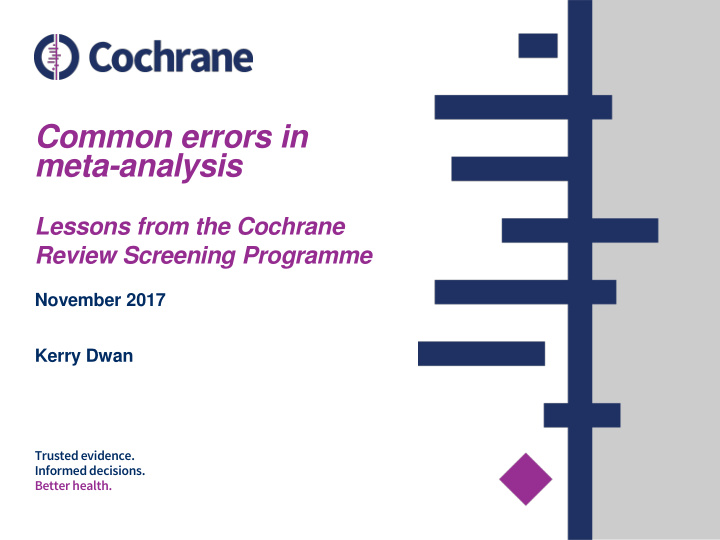



Common errors in meta-analysis Lessons from the Cochrane Review Screening Programme November 2017 Kerry Dwan Trusted evidence. Informed decisions. Better health.
Objectives The objectives of this workshop are to highlight common statistical errors made in Cochrane Systematic Reviews, and to provide practical, hands on learning and guidance to help authors and editors address these errors. ❖ Slides with examples ❖ Practical Exercises ❖ General Discussion
Poll What are your roles in Cochrane? • Editor • Author • Statistician • Other • No role in Cochrane yet
Common Errors • Funny Looking Results • Analyses • Errors we may not see
FLR (Funny Looking Results) 1. Data entry errors/ transposition errors 2. Study weight at odd with sample size 3. Outliers 4. Study ID appearing more than once in a forest plot 5. Reporting at odds with forest plot
FLR #1 -Data Entry Error Poll Which study do you think is probably erroneous? Study 4 • Study 5 • Study 6 •
FLR #1 -Data Entry Error Study 4 Data
FLR #2 – Study weight at odds with sample size Poll Which study do you think is probably erroneous? Study 1 • Study 2 • Question: why? (type the answer in your question box)
FLR #3 – Outliers Minus sign left off mean SEMs used instead of SDs
FLR #4 – Study ID appearing >1 in a forest plot Question: what is the problem with this? (type the answer in your question box)
v v v v v Studies included multiple times
FLR #5 – Reporting at odds with forest plot ‘Higher proportions of participants were reported to experience side effects in the treatment group compared with placebo (100% vs 25%; RR 6.04, 95% CI 2.67 to 13.65)’. Question: what is the issue here? (type the answer in your question box)
FLR #5 – Reporting at odds with forest plot ‘ The confidence intervals for the estimated HR include large benefit and moderate harm of intervention (0.88; 95% CI 0.64 to 1.12), P = 0.43’ Question: what is the issue here? (type the answer in your question box)
Analysis 1. Unit of analysis • Crossover trials (Nolan et al. PLoS ONE 2016) • Cluster trials (Richardson et al. PLoS ONE 2016) 2. Subgroups • Post hoc, wrong analysis, incorrect interpretation • Adequate number of studies, 10? • Specify small number of characteristics in advance with rationale (Donegan et al. PLoS ONE 2016) 3. SMDs and MDs • Used incorrectly, not often back transformed 4. Random effects versus fixed effects • Inconsistently used
1. Unit of analysis • Unadjusted data from study reports used in analysis
Practical Exercise 1
Practical Exercise 1 - Feedback
Practical Exercise 1 – Solutions Figure 1: outcome 1 Figure 2: outcome 2
2. Comparing Subgroups • use a formal statistical test to compare subgroups Abstract : Our Review suggests that (INTERVENTION) may have more beneficial effects in (SUBGROUP) PLS : In the further analyses, there is evidence indicated that the effects of (INTERVENTION) in reducing (OUTCOME) rate may be different between (SUBGROUP 1) and (SUBGROUP 2), with more benefits observed in (SUBGROUP 1)
Practical Exercise 2
Practical Exercise 2 - Feedback
Practical Exercise 2 – Solutions
3. MDs and SMDs “We will convert continuous outcome data into standardised mean differences (SMDs) and present with 95% CIs, as it is assumed that study authors will use different measurement scales. If continuous outcome data is recorded using the same measurement scale, data will be converted into mean differences (MDs) and presented with 95% Cis”. Question: what is the problem here? (type the answer in your question box)
4. Fixed Effect versus Random Effects “We considered statistical heterogeneity between trials to be substantial if, following meta- analysis, I² was greater than 30% and either T² is greater than zero, or there was a low P- value (< 0.10) in the Chi² test for heterogeneity. If substantial heterogeneity was identified used the random-effects (RE) model instead of the fixed- effects (FE) model to pool data”. Question: what is the problem here? (type the answer in your question box)
Errors we may not see • Have any papers been missed? • Have the right results been copied from the papers? • Have the standard deviations been confused with standard errors? Question: Are there any other errors we may not see? (type suggestions in your question box)
Test drive t raining.cochrane.org/common-errors
Final Tips
Tips for spotting errors • Numbers that stand out (perfect homogeneity, single outlying results, sample size does not match with precision relative to other studies) • For non-standard RCT designs - evidence of how SEs were adjusted (check methods against plots). • For primary outcomes select the biggest study or the one that has most weight and check the analysis results against the paper. • For other outcomes pick a study entirely at random and check numbers used against what is available in published trial report or elsewhere. If authors have stated that they got unpublished data then move on to next study.
Discussion
References and resources Nolan SJ, Hambleton I, Dwan K (2016) The Use and Reporting of the Cross-Over Study Design in Clinical Trials and Systematic Reviews: A Systematic Assessment. PLoS ONE 11(7): e0159014. https://doi.org/10.1371/journal.pone.0159014 Richardson M, Garner P, Donegan S (2016) Cluster Randomised Trials in Cochrane Reviews: Evaluation of Methodological and Reporting Practice. PLoS ONE 11(3): e0151818. https://doi.org/10.1371/journal.pone.0151818 Donegan S, Williams L, Dias S, Tudur-Smith C, Welton N (2015) Exploring Treatment by Covariate Interactions Using Subgroup Analysis and Meta-Regression in Cochrane Reviews: A Review of Recent Practice. PLoS ONE 10(6): e0128804. https://doi.org/10.1371/journal.pone.0128804 MECIR http://methods.cochrane.org/mecir t raining.cochrane.org/common-errors
Practical Exercises 3 and 4 - Feedback
Practical Exercise 3 – Solutions
Practical Exercise 4 – Solutions
Practical Exercise 4 – Solutions
Recommend
More recommend